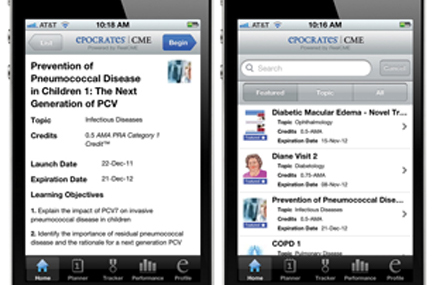Learners on smartphone vs. those who are using the web perform about equally well in most outcomes measures, but online CME activities have a higher completion rate, an analysis showed.
Epocrates and RealCME examined data from their own web and iPhone offerings. Subjects, numbering in the tens of thousands, ranged from physicians to medical students, nurses, nurse practitioners, physican assistants, pharmacists and other healthcare providers, over a range of specialties.
There was no difference cited between the two channels in any of the domains, which included knowledge, competence, confidence and practice. “We don’t see a disadvantage in people taking their activity on a smart phone vs. the web in terms of concentration or attention to activity,” said RealCME CEO Steven Haimowitz, MD.
Nor was there any disparity between the two channels when measured in terms of retention. “We found absolutely consistent data…from both an initial gain and a retention gain [with follow-up survey questions sent 8-12 weeks after the activity],” he added.
On the engagement side, however, the analysis offered up some surprises. “One question people had was you can’t do long activities on the phone—you’ll lose people,” said Haimowitz. “We’re seeing no difference in short vs. long activities on a mobile and online.”
Also, there was a 10% difference in activity completion rates between mobile (61%) and web (72%), with the web channel likely to elicit more completed activities (N=70,000).
In addition, researchers found that mobile seemed to be more format-sensitive than the web. That is, completion rates for mobile activities fell from about 61% for structured activities to about 42% for unstructured ones. Web activities were not subject to the same influence.
From the April 01, 2012 Issue of MM+M - Medical Marketing and Media








